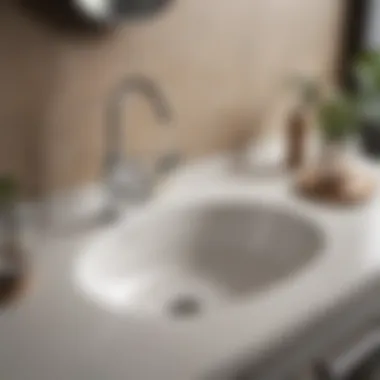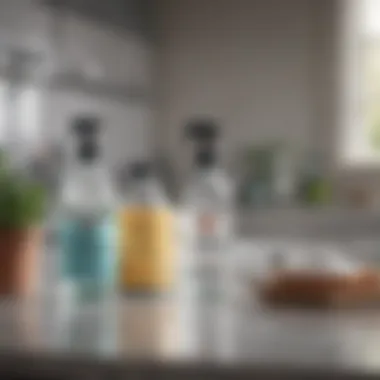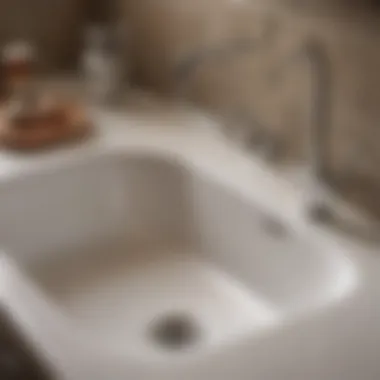Baking Soda Solutions for Clogged Sinks: Your Guide


Intro
Clogged sinks represent a common household challenge that many people face. The usual recourse might involve heavy-duty chemical cleaners that pose health risks and environmental concerns. However, a humble ingredient often found in kitchens around the world—the baking soda—can serve as an effective remedy in these scenarios. This article will explore the insulating properties of baking soda, discuss its advantages over traditional drain cleaners, and consider practical ways to incorporate this solution into routine home maintenance.
Effective Avdantages of Baking Soda
Baking soda, also known as sodium bicarbonate, has certain key properties that make it suitable for unclogging sinks. It is a mild abrasive agent, which can help in breaking down grease that clogs pipes. Moreover, its alkaline properties aid in dissolving acid build-up.
Using baking soda as a drain-cleaning agent offers several significant benefits:
- Eco-Friendly: Free from harsh chemicals, it is safer for both the user and the environment.
- Cost-Effective: Baking soda is inexpensive and easily obtainable, making it a practical solution.
- Multi-Functional: Aside from treating clogged sinks, it can also be used throughout the home for odor control and gentle cleaning.
Step-by-Step Guide to Unclogging Your Sink
To utilize baking soda for unclogging, it is helpful to follow a structured method. This ensures maximum effectiveness and efficiency:
- Gather necessary materials: In addition to baking soda, you will need vinegar, hot water, a measuring cup, and a sink plug.
- Remove standing water: If necessary, clear out excess water from the sink. This helps the baking soda to have direct contact with the clog.
- Add baking soda: Pour half a cup of baking soda into the sink drain.
- Incorporate vinegar: Follow with half a cup of white vinegar. You may notice fizzing—this is a good sign as it indicates a reaction helping to dislodge debris.
- Plug the sink: Cover the sink with a plug or a cloth, to keep the reaction in the drain.
- Wait: Let the solution work for about 30 minutes before rinsing with hot water.
- Rinse: Boil some water and pour it down the drain to remove any remnants of the clog.
Preamble to Clogged Sinks
A clogged sink is a situation many homeowners experience at some point. Understanding why sinks get clogged is fundamental for effective resolution. Various factors contribute to this issue, including the nature of substances being disposed of and regular maintenance practices. By recognizing these common causes, one can take proactive steps to reduce the possibility of clogs, ultimately leading to better home management.
Understanding the Common Causes of Clogs
Clogs can occur due to a range of materials. Grease, soap residue, food particles, and hair often combine to form blockages. These substances can create a sticky build-up in pipes over time. In kitchens, food scraps and oils from cooking can lead to significant issues. In bathrooms, hair and soap often make for prime clogging suspects.
Several contributing factors may exacerbate these causes. Old pipes may be more prone to clogs due to corrosion or accumulation over years. Improper disposal practices, such as flushing non-biodegradable items, can also result in hindrances. Understanding these root causes can greatly aid in prevention strategies, enabling readers to be more conscious in their daily practices.
The Importance of Quick Remedies
Addressing sink clogs promptly is not merely a question of convenience but can prevent more significant issues down the road. Ignoring such problems can lead to backup issues, where water does not drain properly. This condition can escalate, causing not just inconveniences but potential damage to plumbing systems.
Quick remedies enable homeowners to resolve minor problems before they worsen. Leveraging effective and safe solutions—such as using baking soda—can save both time and costs associated with professional plumbing services.
In essence, being aware of the causes and implementing quick methods for resolution ensures a healthier home environment and efficient plumbing functionality. This section sets the groundwork for exploring specific remedies such as baking soda and underscores the importance of prevention in maintaining a functional sink.
The Science Behind Baking Soda
Baking soda, scientifically known as sodium bicarbonate, is more than just a versatile ingredient in baking. Its relevance extends far into household maintenance, particularly regarding clogged sinks. Understanding the chemistry of baking soda contributes significantly to mastering the technique of unclogging drains. This section offers an insightful look into its composition and the ways it interacts with clogs.
Chemical Composition of Baking Soda
Baking soda, or sodium bicarbonate, is composed of sodium (Na), hydrogen (H), carbon (C), and oxygen (O). It’s a white, crystalline powder that is highly soluble in water. When exposed to an acid, such as vinegar, baking soda reacts to release carbon dioxide gas. This reaction not only produces bubbles but also creates a natural agitation effect, which is fundamental in dislodging debris in pipes. Additionally, its alkaline property helps neutralize certain substances in a clog, paving the way for a more effective cleaning process.


Some benefits of baking soda's chemical structure include:
- Safety: Its non-toxic nature makes it safe for both users and plumbing systems.
- Multi-functionality: Works effectively against diverse material buildup in pipes, including grease and organic materials.
Understanding these chemical properties is essential for effectively utilizing baking soda in unclogging sinks.
How Baking Soda Affects Clogs
Baking soda combats clogs through multiple mechanisms. First, as mentioned earlier, when combined with an acid, like vinegar, the reaction generates bubbles. This bubbling action serves to agitate and loosen accumulated substances in the drain. The barrier strains of accumulating debris can be tackled with this simple yet effective reaction.
The basic properties of baking soda also contribute to deodorizing odors. As clogs often result from organic material decomposition, using baking soda can neutralize unpleasant smells generated in sinks.
The introduction of water alongside baking soda can produce a more robust cleaning solution, further facilitating the dissolving of harsh stairs from the elements and debris. During the rinsing period following treatment, water helps wash away remnants, giving an additional boost to the unclogging power.
Important: Always ensure that your sink is wet before applying any baking soda to promote optimal results.
By exploiting these scientific attributes, baking soda emerges as a practical remedy for sink clogs. Its dual functionality in disrupting clogs and eliminating odors presents a straightforward yet powerful approach to hindering this common household issue.
Advantages of Using Baking Soda
Baking soda is more than just a common ingredient found in most kitchens. When dealing with clogged sinks, it serves as an effective and multifaceted solution. There are numerous benefits contingent on this simple compound that elevate it beyond traditional clog-clearing methods.
Cost-Effectiveness
A notable advantage of using baking soda is its cost-effectiveness. Unlike commercial drain cleaners, which can be expensive and often require more than one application, baking soda is inexpensive and typically outlasts its priced equivalents. Given the filtering and neutralizing attributes of baking soda, one application can often provide immediate results. For households dealing with frequent clogs, the savings compound significantly, as investing in a single box of baking soda yields better long-term results than repeatedly purchasing chemical alternatives. With a small upfront cost, it also serves as a proactive palette for cleaning, addressing immediate needs and offering consistent maintenance for plumbing.
Environmental Benefits
From an environmental standpoint, baking soda emerges as the shining hero in leak prevention and pollution reduction. Most store-bought drain cleaners contain harsh chemicals that not only harm pipes but also wreak havoc on the ecosystem once washed away.
Baking soda does not carry those burdens. It breaks down naturally and does not contribute to water pollution. Unlike chemical solutions, which may require special disposal methods due to their hazardous qualities, a simple solution of baking soda and vinegar produces minimal environmental impact. Users thus engage in eco-friendly practices simply by opting for baking soda, marking their contributions towards sustainability.
Safety for Both Users and Pipes
Safety in using baking soda cannot be overstated. For homeowners and renters alike, the non-toxic nature of baking soda creates a secure atmosphere during application. In comparison to the corrosive agents found in many commercial drain cleaning products, baking soda poses negligible health risks.
Additionally, professional plumbing advice overwhelmingly supports the application of baking soda as safe for plumbing systems. It does not corrode pipes or contribute to wear over time. Instead, baking soda can assist in maintaining the health of pipes, promoting smoother water flows and decreasing the overall likelihood of future issues.
Baking soda provides a solution that is not only effective in resolving clogs but also emphasizes cost savings and environmental consciousness.
In summary, leveraging baking soda as an effective remedy for clogged sinks weaves through practical benefits. Its affordability, eco-friendliness, and safety collectively make it a commendable choice. Furthermore, with baking soda on hand, maintaining clean and functional sinks becomes a straightforward, affordable endeavor not dictated by hefty service costs or chemical exposure.
Step-by-Step Guide to Using Baking Soda for Clogs


Using baking soda for clogs is a practical approach that combines science with everyday problem-solving. This section elaborates on effective techniques to resolve sink problems. Understanding the importance of this method helps to appreciate its usefulness in maintaining household plumbing. This guide not only offers a clear framework to follow but also amplifies the advantages of using a common pantry item instead of chemical cleaners. Careful execution ensures safer handling and optimal results.
Gather Necessary Materials
Before starting the clog removal process, a few basic materials are needed. Having everything on hand saves time and frustration. You will require thoroughly:
- Baking soda: The main ingredient that acts as a natural abrasive and deodorizer.
- White vinegar: This natural acid pairs well with baking soda, creating a chemical reaction that helps dissolve clogs.
- Hot water: Use tap water for rinsing down the sink after treatment. It can help move debris along in the pipes.
- Measuring cup: To measure the right amounts of baking soda and vinegar.
- Cloth or cap: Something to seal the sink drain for a short time during the process should be available.
By preparing these items in advance, you can follow the steps without disruptions.
Initial Preparation of the Sink
Preparation is crucial for effectively combating a clog. Begin with a clean workspace. Clear the sink of any dishes or debris. This ensures you have a focused area for the task at hand. Next, inspect the drain for visible obstructions. Sometimes hair, food particles, or other materials can be seen. If anything is visible, remove it to enhance the effectiveness of your approach. Also, make sure the area around the sink is dry to avoid slipping. Ultimately, good preparation minimizes hassle during the process while maximizing effectiveness.
Applying Baking Soda and Vinegar
Now for the key part: an efficient application. Start by pouring about one cup of baking soda directly into the clogged drain. Follow up quickly with one cup of vinegar. The reaction will generate fizzing action, a sign that the mixture is working to break down the clogs.
Immediately cover the drain with a cloth or drain cap. This traps the fizzing action and enhances the effect of the reaction within the pipe.
Wait approximately 30 minutes to let this mixture do its job. This time is crucial for allowing both ingredients time to target the blocking materials effectively.
Rinsing the Sink
After sufficient waiting time, it's time to rinse the sink. Boil a kettle to prepare hot water. Carefully, pour hot water down the drain to flush away the debris loosened by the baking soda and vinegar mixture. Make sure you run enough hot water to effectively flush the system. Ideally, use about two boiling cups. Watch how your sink begins to drain freely. If the water drains well, the process has likely worked.
Repeat as Necessary
You may need to repeat this process. For persistent clogs that do not respond to the initial attempt, repeating the sequence is vital. Additional applications of one cup of baking soda, followed by one cup of vinegar, may effectively tackle deeper blockages. As you repeat, always follow up with hot water. Consistent application does not only clear the initial obstruction but helps prevent future buildup as well. By learning to use baking soda correctly, you gain an effective tool for home maintenance with minimal effort.
Preventative Measures for Sink Clogs
Preventing sink clogs is not only essential for maintaining smooth water flow but it is also a key aspect of effective home maintenance. When unseen particles accumulate over time, they can lead to severe blockages which are often costly and time consuming to repair. Practicing preventative measures helps homeowners avoid the burden of clogs, enhances the longevity of plumbing, and contributes to enhanced overall hygiene within the home.
Regular Cleaning Practices
Implementing regular cleaning practices is crucial to keeping your sink drains free from clogs. A systematic approach to cleaning can significantly reduce debris responsiveness to moisture and can minimize buildup of harmful materials.
Some effective cleaning practices include:
- Routine Pouring of Hot Water: Once a week or bi-weekly, pouring boiling water down the drain can help dissolve fats or oils that may accumulate from regular kitchen usage.
- Baking Soda and Vinegar: Performing a monthly treatment with a mix of baking soda and vinegar can be very helpful. Simply pour half a cup of baking soda followed by half a cup of vinegar down the drain, let it sit for about 30 minutes, then rinse with hot water.
- Use a Drain Strainer: Always use a strainer in your sink,” as it can catch food particles and other materials before they slip into the drain.
- Dry Clean with Baking Soda: A layer of baking soda spread across your drain can dry out leftover grease that could solidify and accumulate, guiding particles towards an easier exit.
Apply these methods consistently to maintain clean pipes and to encourage free paths for waste. Vigilance and routine are insurance against the frustrations of a clogged sink.
Avoiding Certain Materials in Drains
Being aware of what materials should not be allowed to enter your plumbing system is equally important. Some substances have a higher tendency to cause clogs, leading homeowners to engagements that often involve troubles and discomfort.


Consider these practices when using your sink:
- Fats, Oils, and Grease: Though often easy to wash down when hot, these substances cool and solidify within pipes. Dispose these pitches into containers instead.
- Coffee Grounds: Used coffee grounds tend to aggregate and clump, creating a worrisome barrier in pipes. Scrape them into the trash to keep your drain clean.
- Starchy Foods: Items such as rice and pasta can swell when they absorb water, leading to significant blockages. Place fibrous leftovers into your bin as alternative.
- Harsh Chemicals: Avoid pouring harsh chemicals down the drain. They can corrode pipes and lead to bigger problems.
By being proactive and adhering to practices that restrict foreign substances in the sink, you can prevent clogs before they happen, thereby ensuring peace of mind.
Adopting these preventative measures is’ cost-effective and helps create a hygiene-friendly environment at home.
When to Seek Professional Help
Understanding when to turn to professional services for a clogged sink is crucial in maintaining the long-term functionality of your plumbing system. While baking soda can effectively dislodge many clogs, it is important to recognize scenarios where that approach might fail. Identifying these situations early can save time, frustration, and potentially reduce costly damage to your property.
Identifying Severe Clogs
Severe clogs are often evidenced by multiple signs that indicate a more significant issue within your plumbing. A particularly concerning situation is when a clogged sink impacts multiple areas. For example, if you notice that water drains poorly not only in the sink but also in the nearby bathtub, then the whole drainage system might be affected.
Pay attention to persistent odors or standing water that does not clear. You should also be wary of unusual gurgling sounds when you try to run water. These signs suggest a possible blockage deeper in the plumbing system.
Here are some indications that you may have a severe clog:
- Water pooling at or around the drain
- Slow drainage across several fixtures
- Backflow of water or debris into sinks or drains
- Frequent need for drain cleaning products or methods
If you encounter these symptoms repeatedly or otherwise suspect a major obstruction, contacting a plumbing professional is prudent.
Understanding When DIY is Insufficient
Every homeowner should be armed with basic remedial skills for small plumbing issues. However, it's crucial to accept that some situations demand the oversight of trained professionals. A DIY approach can effectively address minor clogs, yet certain cases warrant a pause for caution.
One of the main reasons to seek help revolves around using heavy-duty tools or locations that are difficult to reach. Attempting to eliminate stubborn clogs without proper expertise can lead to recurring issues or even unnecessary damage.
Consider these points:
- Using harsh chemical drain cleaners may irreversibly damage plumbing materials.
- Repeated attempts to clear a clog could worsen the blockage, leading to more consequential plumbing repairs.
- A professional can conduct sewer line inspections and provide diagnostics, which may be beyond the scope of conventional homeowners’ efforts.
End
Addressing a clogged sink is a common household issue that, if unresolved, can lead to significant inconvenience and potential damage. This article examined several aspects regarding the remedies for clogged sinks, particularly focusing on the utility of baking soda. Utilizing baking soda as a primary tool offers numerous advantages, such as being cost-effective, safer for the environment, and safer for your plumbing.
Summary of Key Points
- Effective Use of Baking Soda: Baking soda, when combined with vinegar, acts as a powerful agent that helps in dislodging many types of food particles and residues that migh obstruct water flow.
- Preventive Measures: Regular maintenance practices can effectively keep the elements that cause clogs at bay. Simple regular cleaning can protect against some common offenders.
- Professional Assistance: While some clogs can be addressed using baking soda and vinegar or minor DIY fixes, understanding the point at which professional help is required is crucial. Severe clogs may need specialized assistance to resolve.
The importance of employing these remedies goes beyond just quick fixes; it offers complete home maintenance solutions, focusing on convenience and sustainability.
The Value of Home Maintenance
Home maintenance often goes overlooked in daily life. However, the discipline of regular checks and simple upkeep can pay off in broader ways. Not only can managing a simple task like a clogged sink improve daily functionality, but it can also cultivate long-term health for plumbing systems. Investing time in preventive care can extend the life of pipes, reduce hazardous situations, and invariably save money on costly repairs. Maintaining your home facilitates a seamless and efficient living environment. This contributes not only to property value but creates peace of mind, allowing individuals to enjoy their surroundings without the burden of unexpected disruptions.
In summary, prioritizing the maintenance of household drains through sensible practices, use of natural remedies, and staying informed propels any household towards a more harmonious and sustainable future.



